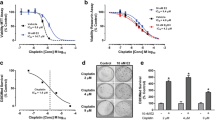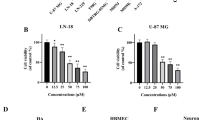Abstract
The purpose of this study was to investigate the potential effects of 2-methoxyestradiol, a natural mammalian steroid, in glioma cells, since antiproliferative effects of this compound had been shown earlier in several leukemia and carcinoma cell lines. The effects of 0.2, 2 and 20 μM concentrations of 2-methoxyestradiol were measured in three malignant human glioma cell lines (U87MG, U138MG, LN405) and one malignant rat glioma cell line (RG-2) using a microtiter-tetrazolium (MTT) assay. In all cell lines, a significant reduction of the viable cell number by more then 75% occurred ( P < 0.05) for concentrations of 2 and 20 μM 2-methoxyestradiol after 6 days. A concentration of 0.2 μM had smaller effects (10–40% cell reduction), which were significant in two of the cell lines tested. The apoptotic nature of cell death was further analyzed in U87MG and RG-2 cells. Caspase-3 activity was significantly induced to levels between 3.4- and 23-fold after 4 days for the two higher 2-methoxyestradiol concentrations (P < 0.05). In the cell line RG-2 nuclear fragmentation was visible in many nuclei, following stains with Hoechst H33258. A round cell morphology occurred in most treated cells, which was not accompanied by a complete destruction of the microtubule network, as it can be observed with other microtubule targeting drugs.
Similar content being viewed by others
References
N Klauber S Parangi E Flynn E Hamel RJ D’Amato (1997) ArticleTitleInhibition of angiogenesis and breast cancer in mice by the microtubule inhibitors 2-methoxyestradiol and taxol Cancer Res 57 81–86
LR Quadan CM Perez-Stable C Anderson G D’Ippolito A Herron GA Howard BA Roos (2001) ArticleTitle2-methoxyestradiol induces G2/M arrest and apoptosis in prostate cancer BBRC 285 1259–1264
MN Zoubine AP Weston DC Johnson DR Campbell SK Banerjee (1999) ArticleTitle2-methoxyestradiol-induced growth suppression and lethality of estrogen-responsive MCF-7 cells may be mediated by down regulation of p34cdc2 and cyclin B1 expression Int J Oncol 15 639–646
G Schumacher M Kataoka JA Roth T Mukhopadhyay (1999) ArticleTitlePotent antitumor activity of 2-methoxyestradiol in human pancreatic cancer cell lines Clin Cancer Res 5 493–499
TM LaVellee XH Zhan CJ Herbstritt EC Kough SJ Green (2002) ArticleTitlePribluda VS: 2-methoxyestradiol inhibits proliferation and induces apoptosis independently of estrogen receptors alpha and beta Cancer Res 62 3691–3697
C Lippert H Seeger AO Mueck (2003) ArticleTitleThe effects of endogeneous estradiol metabolites on the proliferation of human breast cancer cells Life Sci 72 877–883
TM LaVallee XH Zhan MS Johnson CJ Herbstritt G Swartz MS Will WA Hembrough SJ Green VS Pribluda (2003) ArticleTitle2-methoxyestradiol up-regulates death receptor 5 and induces apoptosis through activation of the extrinsic pathway Cancer Res 63 468–475
RJ D’Amato CM Lin E Flynn J Folkman E Hamel (1994) ArticleTitle2-methoxyestradiol, an endogeneous mammalian metabolite, inhibits tubulin polymerization by interacting at the colchicin site Proc Natl Acad Sci USA 91 3964–3968
M Cushman HM He JA Katzenellenbogen CM Liu E Hamel (1995) ArticleTitleSynthesis, antitubulin and antimitotic activity, and cytotoxicity of analogs of 2-methoxyestradiol, an endogeneous mammalian metabolite of estradiol that inhibits tubulin polymerization by binding to the colchicine binding site J Med Chem 38 2041–2049
Hamel E CM Lin RJ D’Amato (1996) ArticleTitleInteractions of 2-methoxyestradiol, an endogeneous mammalian metabolite, with unpolymerized tubulin and with tubulin polymers Biochemistry 35 1304–1310
M Cushman AK Mohanakrishnan M Hollingshead E Hamel (2002) ArticleTitleThe effect of exchanging various substituents at the 2-position of 2-methoxyestradiol on cytotoxicity in human cancer cell cultures and inhibition of tubulin polymerization J Med Chem 45 4748–4754
TL Tinley RM Leal DA Randall-Hlubek JW Cessac LR Wilkens PN Rao SL Mooberry (2003) ArticleTitleNovel 2-methoxyestradiol analogues with antitumor activity Cancer Res 63 1538–1549
S Haldar A Basu CM Croce (1997) ArticleTitleBcl2 is the guardian of microtubule integrity Cancer Res 57 229–233
Author information
Authors and Affiliations
Corresponding author
Additional information
K. Chamaon: These authors contributed equally to the work.
J. Stojek: These authors contributed equally to the work.
Rights and permissions
About this article
Cite this article
Chamaon, K., Stojek, J., Kanakis, D. et al. Micromolar concentrations of 2-methoxyestradiol kill glioma cells by an apoptotic mechanism, without destroying their microtubule cytoskeleton . J Neurooncol 72, 11–16 (2005). https://doi.org/10.1007/s11060-004-2158-4
Issue Date:
DOI: https://doi.org/10.1007/s11060-004-2158-4




